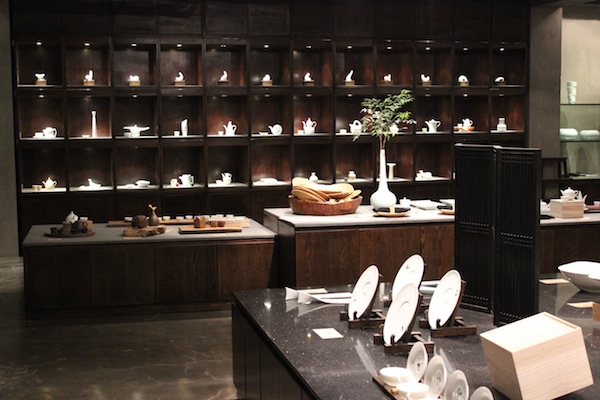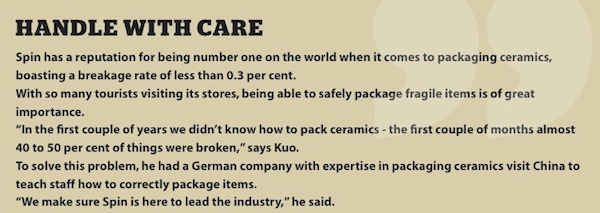 It’s rarity to see homegrown, innovative design in China, a country world renowned for its skill in producing copies and rip-offs.
It’s rarity to see homegrown, innovative design in China, a country world renowned for its skill in producing copies and rip-offs.
So wandering off Shanghai’s Kangding Lu in Jingan district into the unassuming flagship store of ceramics designer and manufacturer, Spin, is a shock – even for attendees of the Westfield World Retail Study Tour.
We’re not the only ones who have been taken aback by the air of quality and style at the two storey store, with founder Jeremy Kuo telling the tour he’s coined a term especially for it – “mm mm wah”.
“Spin is very famous for mm mm wah,” Kuo relates to the group.
“The first time they come into Spin they look at something and they say ‘mm’. Then they look to their left, and say, ‘mm’, and then they pick up the price tag and say ‘wah!’
“They love our price, so that’s why Spin is called mm mm wah shop,” he says.
It’s taken almost nine years to get to this point, starting out when Kuo, a retired professor from Japan, began looking for a local supplier of quality, affordable crockery to use in his three Shanghai restaurants.
He had previously sourced these products from Japan.
“One day I thought why don’t I just get them here in China, so I flew to Jingdezhen to look for something, but it made me very depressed because I found nothing,” says Kuo, of the poor quality and design of Chinese products.
“So I began to design my own plates and bowls and found one or two makers to make them for me. I used them in my own restaurant, but the customers liked it.”
And so, the idea of Spin was born. Kuo teamed up with friend and artist Gary Wang as art director to create their own brand.
But if Kuo was depressed at the lack of quality ceramics in the market, he was soon to become even more depressed.
“I went to talk to the professor at the Institute of Ceramics, and he told me no one in China wants to raise their quality. In China the ceramics industry only does copies not design, they just copy Japanese or European products.”
At the time, many Chinese design students were left without employment at the end of their education, so Kuo decided to take matters into his own hands, recruiting five young designers.
In the first two and a half years of business, using a small kiln, Spin produced 60 designs. Within two and a half months of opening in Shanghai, the Spin store had sold out of almost everything.
“That was the time I realised I had to solve the production problem. I had thought our workshop might be enough to supply the store, but I was totally wrong.”
After a huge struggle to find ceramics makers willing to produce quality pieces from fresh designs, Kuo now uses three manufacturers from China’s ceramics capital of Jingdezhen.
From here, Spin grew in leaps and bounds. In the first two years it grew 50 per cent a year.
From that point on it has grown steadily at 25 to 30 per cent a year, and is now 10 times the size of the first year. It has sold more than 15,000 pieces from 7000 designs.
There are now three Spin stores in China and two franchised stores in Singapore. Eighty per cent of its customers are foreigners, with the remaining 20 per cent locals purchasing for corporate and personal gifts. Four years ago the business had no local customers.
“Most local people accidentally drop in thinking it’s a gallery, but once they come in they work out within 30 seconds it’s not, because our designs are far too simple for Chinese people.
“They can’t see any complicated designs so they don’t consider these designs, they are looking for something fancier.”
Spin philosophy
Spin’s focus is on affordable design, with every design produced in limited quantities of between 300 and 800.
On the door of the Shanghai store, what the brand stands for is stated clearly: Simple, elegant, fluent, organic.
“Gary and I took something complicated, and made it static, stable, non-moving, symmetrical, and organic. Simple and refined,” says Kuo.
“It is always about the people first. Gary and I are outsiders and we learned everything ourselves, we started from scratch and learned on the way.
“We’re still learning, we’re still making mistakes, and we are going to make more.
“Since we focus on design, production comes second. Many of our products are handmade. They are not identical.”
This is one of the reasons Spin has refrained from e-commerce. “We prefer people coming in here seeing and touching and feeling the product and then making the purchase.
“Why don’t we have products on our website? We want to be the leader of design. Expanding our sales volume has never my priority.
“Our mission is to set up and develop a good designer team in China, because it’s what China needs most – a good design team that don’t just do copies.”
Kuo’s background in training and education has also provided the backbone for the business, with Spin’s designers all recruited as students from Chinese ceramic design colleges.
“It is very difficult to do good design, it takes at least 10 years if not more. The difficult part of Chinese young designers is they have no experience of enjoying a good life.
“For those who’ve never drank good coffee, you can’t expect them to design a very good coffee mug. For those who’ve never enjoyed good French or Japanese food, it’s difficult for them to design dinnerware, so this is their weakness.
“I spend most of my time trying to help these new designers fine tune [their skills] by giving them these experiences and making them more aware.”
This story originally appeared in Inside Retail Magazine’s August/September 2013 edition as part of our exclusive coverage on the 2013 Westfield World Retail Study Tour.
Inside Retail Magazine’s December/January 2014 issue, featuring Inside Retail Magazine’s annual Shopping Centre Development Guide is available now. For more information, click here.









